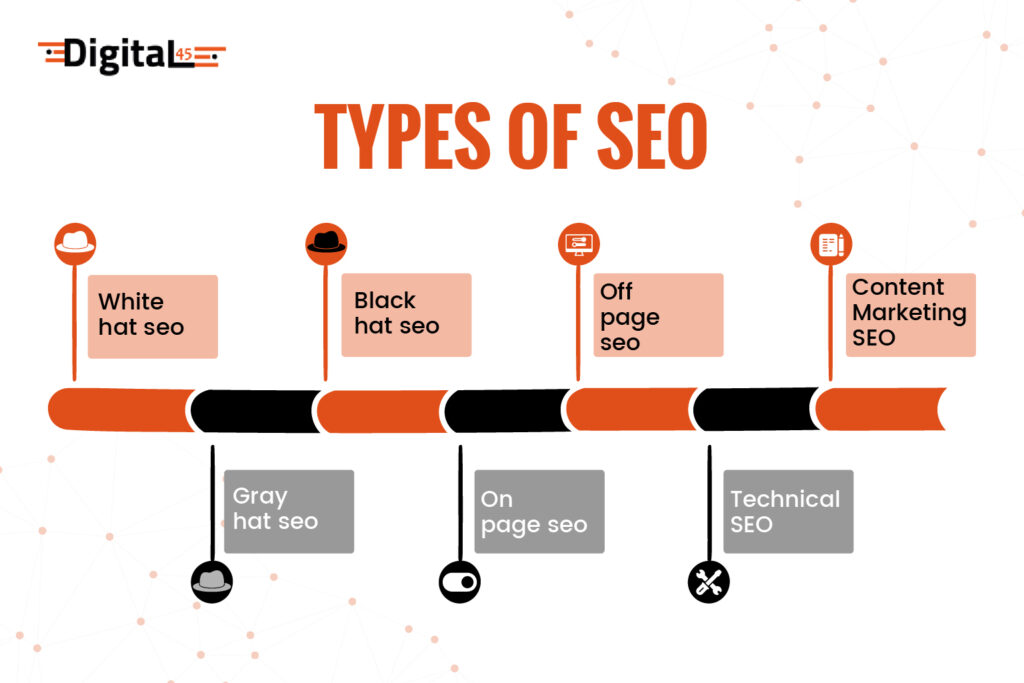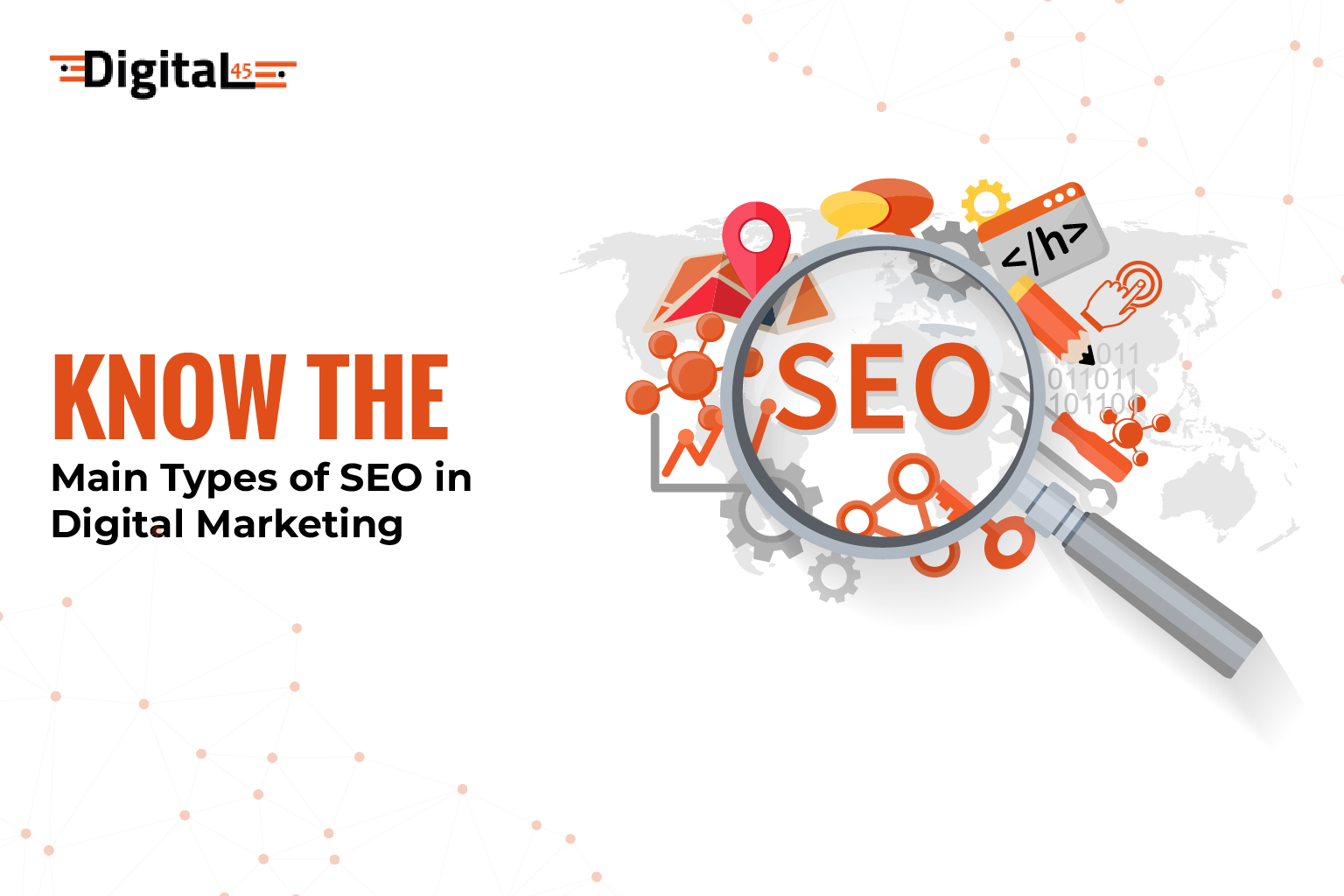SEO, or Search Engine Optimization, is a crucial aspect of digital marketing that can significantly impact a website’s online visibility and organic search rankings.
In today’s competitive online landscape, understanding the different types of SEO is essential for businesses and marketers to stay ahead.
According to a recent study, 93% of online experiences begin with a search engine, highlighting the importance of SEO services in Ahmedabad for increasing brand awareness.
What is SEO?
Before delving into the different types of SEO, it is crucial to understand what SEO is and its primary goal. SEO refers to optimizing a website to improve its visibility on search engine results pages (SERPs) and increase organic traffic.
The primary goal of SEO is to rank higher on search engine results for relevant keywords, thereby driving targeted traffic to a website.
Search engines like Google use complex algorithms to determine the relevance and quality of websites and their content. SEO services in India help businesses align their websites with these algorithms, making it more likely to be indexed and ranked favourably by search engines.
Main Types of SEO
On-Page SEO:
On-page SEO refers to the optimization techniques applied directly on a website’s pages to improve its search engine rankings. Two key components of on-page SEO are keyword research and content optimization.
-
 Keyword research:
Keyword research:
Keyword research is a critical aspect of on-page SEO as it helps identify the keywords and phrases that potential customers use when searching for products or services.
By understanding these keywords, businesses can create content that aligns with user intent and improves their chances of ranking higher on search engine results.
To find relevant keywords, businesses can utilize various keyword research tools such as Google Keyword Planner, SEMrush, or Moz. These tools provide valuable insights into search volume, competition, and related keywords, enabling businesses to optimize their content effectively.
-
Content optimization:
Creating high-quality, valuable, and relevant content is crucial for on-page SEO. Content optimization involves strategically incorporating keywords into the content to improve its visibility and search engine rankings.
Key elements of content optimization include title tags, meta descriptions, headings, and internal linking.
Title tags: Title tags are HTML elements that define the title of a webpage. Including relevant keywords in the title tag helps search engines understand the content of the page and improves its visibility in search results.
Meta descriptions: Meta descriptions provide a brief summary of a webpage’s content. Optimizing meta descriptions by including relevant keywords can entice users to click on the link when it appears in search results.
Headings: Properly formatted headings (H1, H2, H3, etc.) help search engines understand the structure and hierarchy of a webpage’s content. Including relevant keywords in headings can improve a webpage’s visibility and user experience.
Internal linking: Linking relevant pages within a website helps search engines understand the interconnectedness of content. It also improves user navigation and engagement, which can positively impact search engine rankings.
Off-Page SEO:
Off-page SEO refers to the optimization techniques applied outside of a website to improve its search engine rankings. Two crucial components of off-page SEO are backlink building and social media signals.
-
Backlink building:
Backlinks are links from other websites that point to a particular webpage. Search engines consider backlinks as votes of confidence, indicating that the linked webpage is valuable and relevant. The more quality backlinks a webpage has, the higher its chances of ranking well in search results.
Businesses can acquire quality backlinks by creating compelling content that other websites naturally want to link to. Additionally, actively reaching out to industry influencers, guest blogging, and participating in online communities can help build a strong backlink profile.
-
Social media signals:
Social media signals refer to the impact of social media platforms on a website’s organic search visibility. Search engines consider the popularity and engagement on social media platforms when determining the relevance and credibility of a website. Therefore, leveraging social media platforms can greatly enhance off-page SEO.
To leverage social media for SEO, businesses should create engaging and shareable content, actively engage with their audience, and encourage social sharing of their content. Additionally, including social sharing buttons on webpages can make it easier for users to share content, thus increasing its visibility.
Technical SEO:
Technical SEO refers to the optimization techniques focused on improving a website’s technical aspects that can affect its search engine rankings. Two key components of technical SEO are website speed optimization and mobile-friendliness.
-
Website speed optimization:
Website loading speed plays a critical role in user experience and search engine rankings. Slow-loading websites not only frustrate users but also negatively impact SEO. Search engines prioritize websites that offer a seamless user experience, including fast loading times.
To improve website speed, businesses can minimize file sizes by compressing images, reduce server response time, leverage browser caching, and utilize content delivery networks (CDNs). Tools like Google PageSpeed Insights can provide insights into specific areas of improvement.
-
Mobile-friendliness:
The importance of mobile devices in search engine results has grown significantly in recent years. Search engines prioritize mobile-friendly websites to cater to the increasing number of users accessing the internet through mobile devices.
To optimize websites for mobile users, businesses should ensure responsive design, meaning the website adapts to different screen sizes and resolutions. Additionally, optimizing page speed, using legible fonts, and providing seamless navigation on mobile devices are crucial for mobile-friendliness.
Emerging Trends in SEO:
The world of SEO is constantly evolving, and it is essential for businesses and marketers to stay updated with the latest trends and developments. Some emerging trends in SEO include voice search, artificial intelligence (AI), and user experience (UX) optimization.
Voice search: With the rise of voice assistants like Siri, Alexa, and Google Assistant, voice search has become increasingly popular. Optimizing content for voice search involves understanding natural language queries and creating conversational content that matches user intent.
Artificial Intelligence (AI): AI plays a significant role in search engine algorithms, helping search engines deliver more accurate and relevant search results. Businesses can leverage AI by utilizing AI-powered tools for keyword research, content optimization, and data analysis.
User experience (UX) optimization: User experience has become a crucial factor in search engine rankings. Search engines prioritize websites that offer a seamless and intuitive user experience. Therefore, businesses should focus on optimizing website navigation, page speed, mobile-friendliness, and overall user engagement to improve their search engine rankings.
Final Verdict
SEO is a fundamental aspect of digital marketing that businesses and marketers should prioritize to improve their online visibility and organic search rankings. It is crucial to stay updated with emerging SEO trends and adapt strategies accordingly to ensure continued success in the ever-evolving digital landscape.
So, don’t wait any longer and hire the best SEO Services in Ahmedabad– and take your digital marketing to the next level. Digital45 offers a range of services designed to enhance a website’s performance in search results. Our expertise and strategies are essential for businesses looking to establish a strong online presence and achieve marketing goals.



